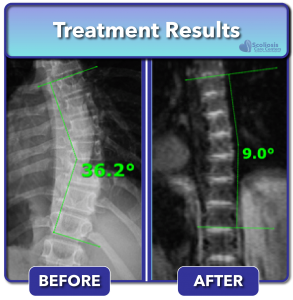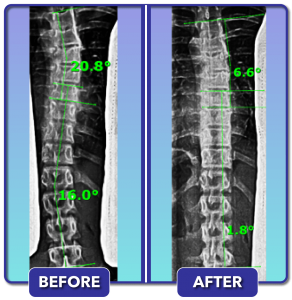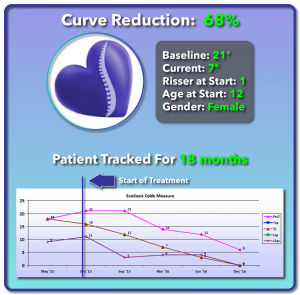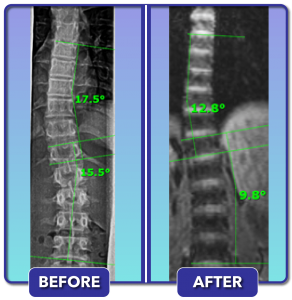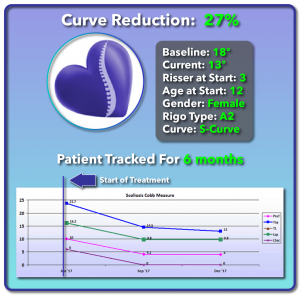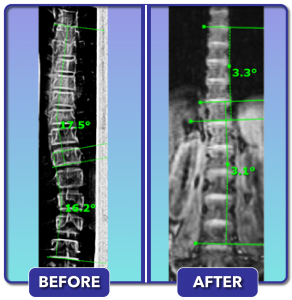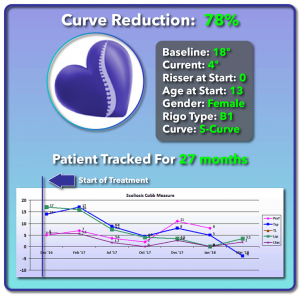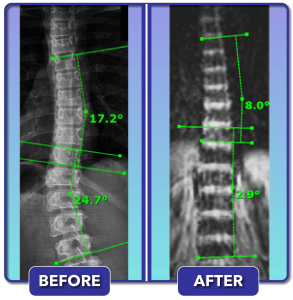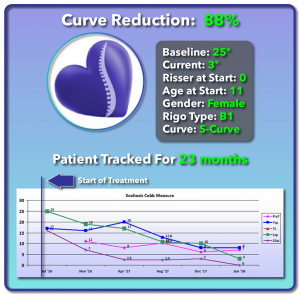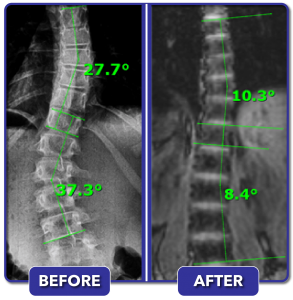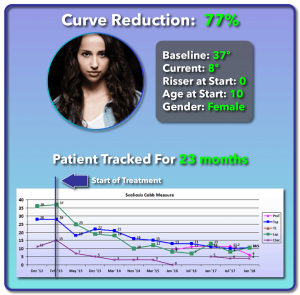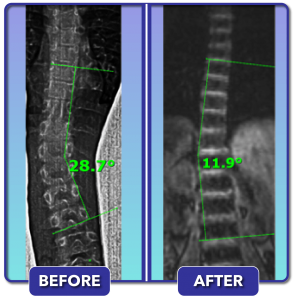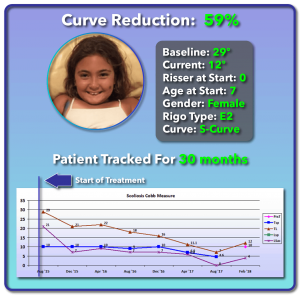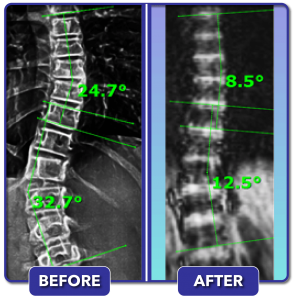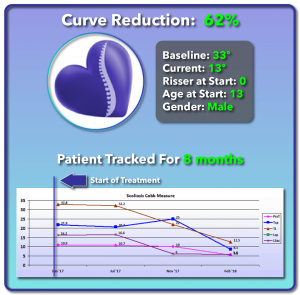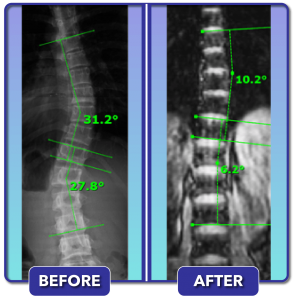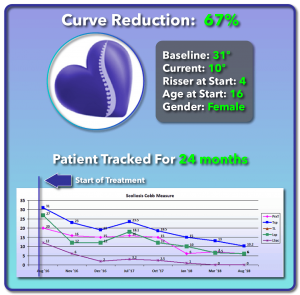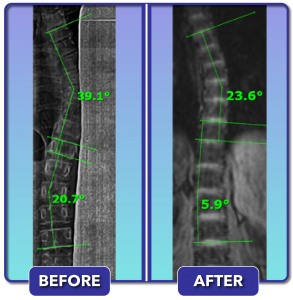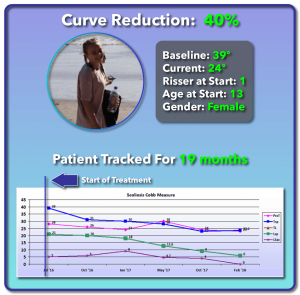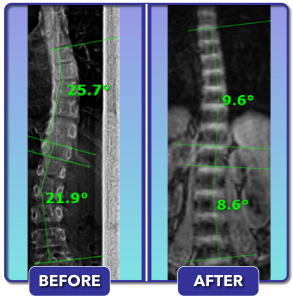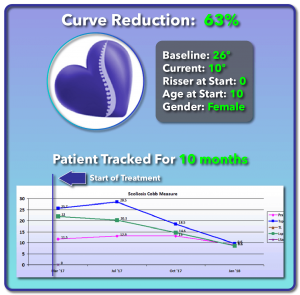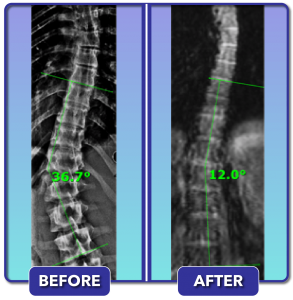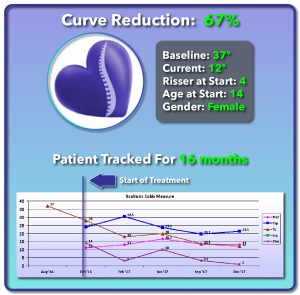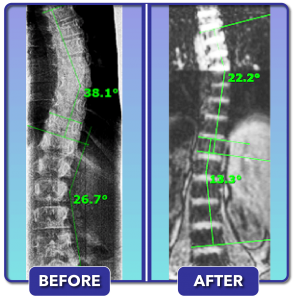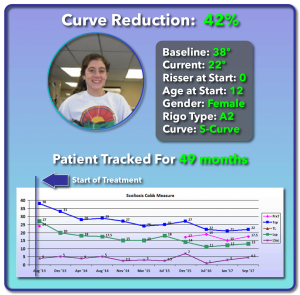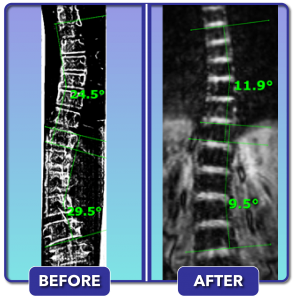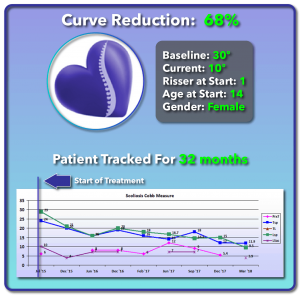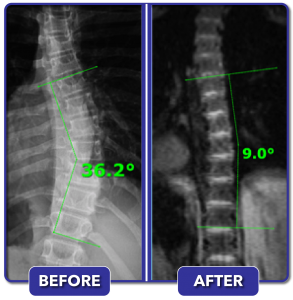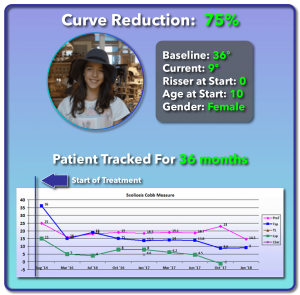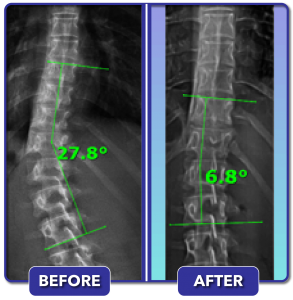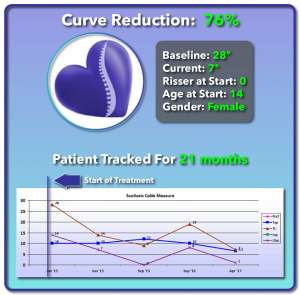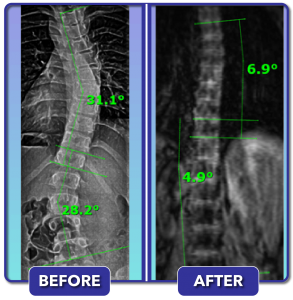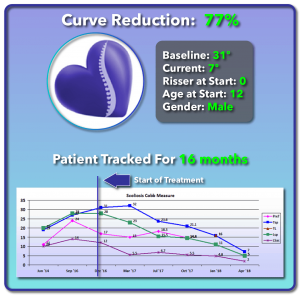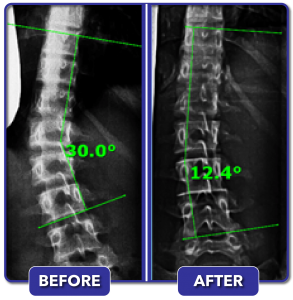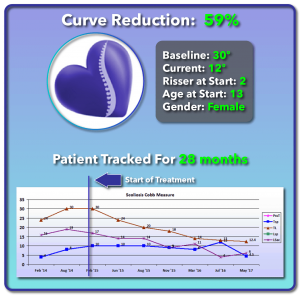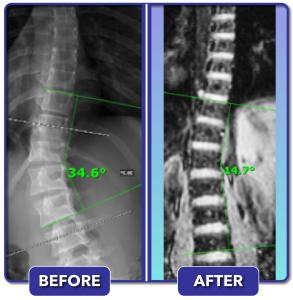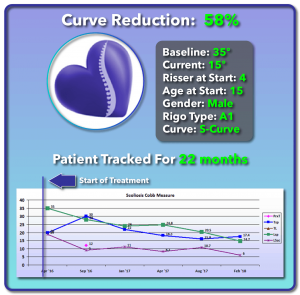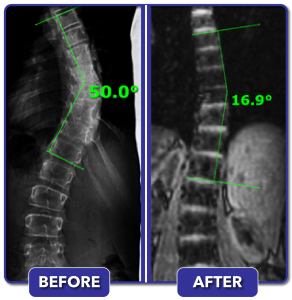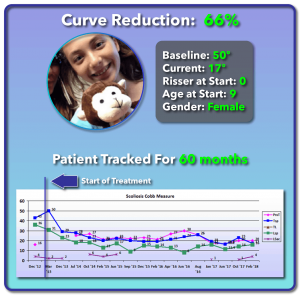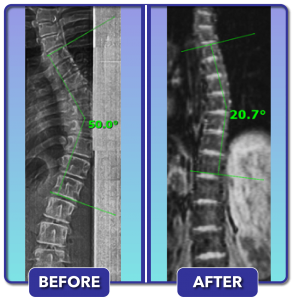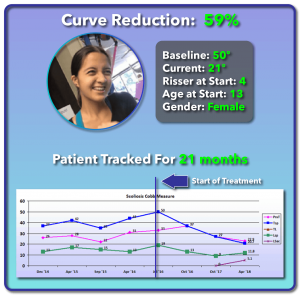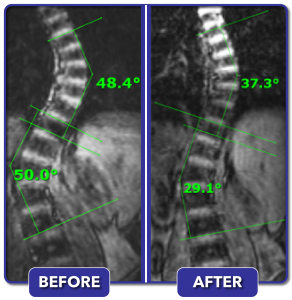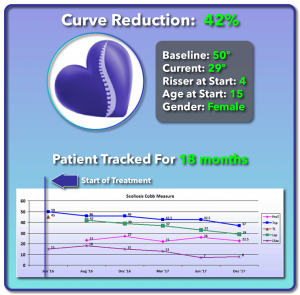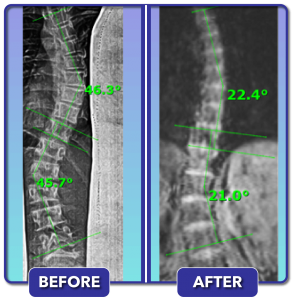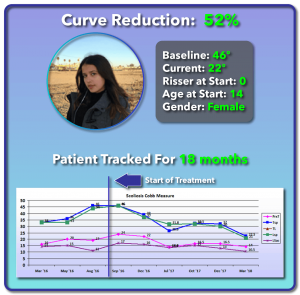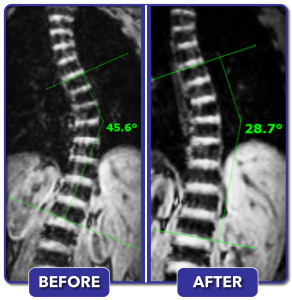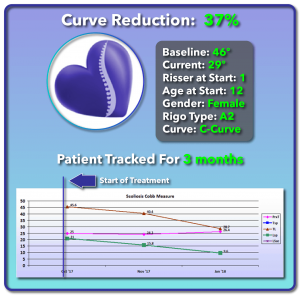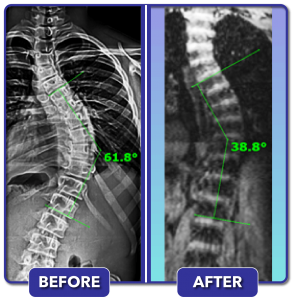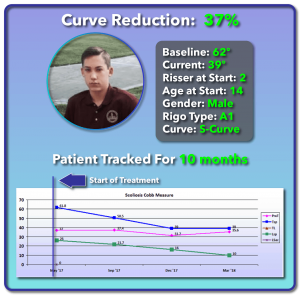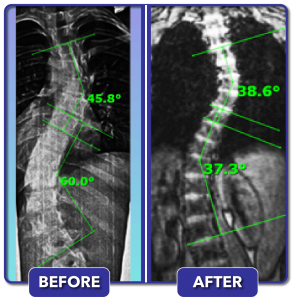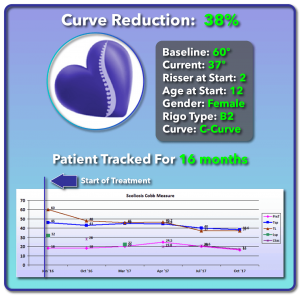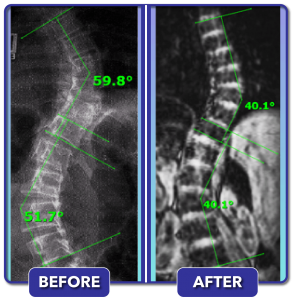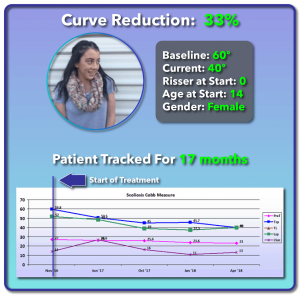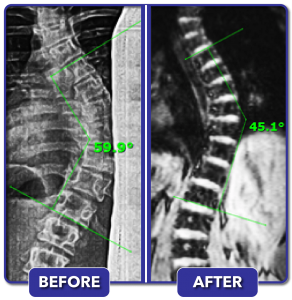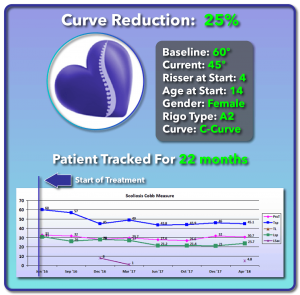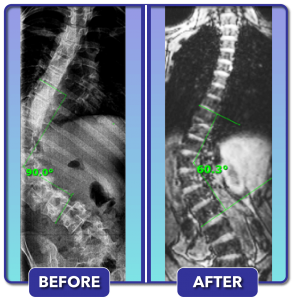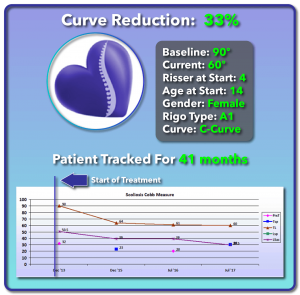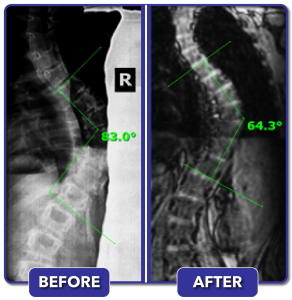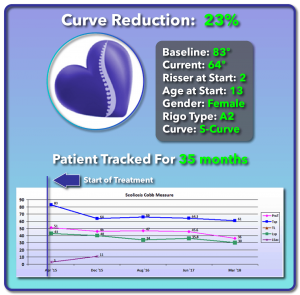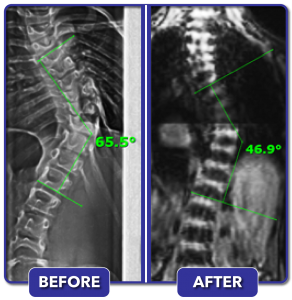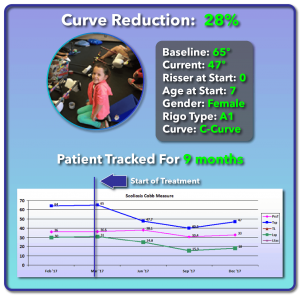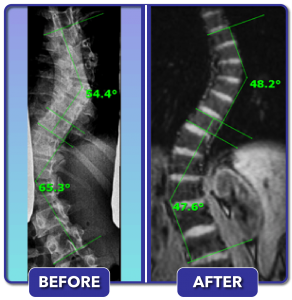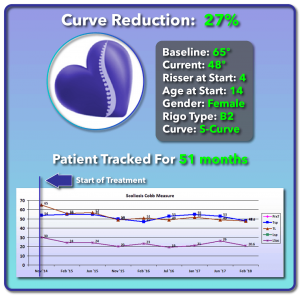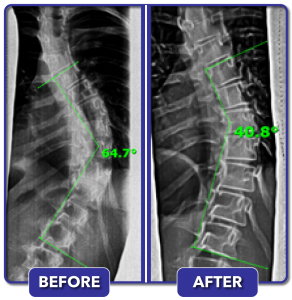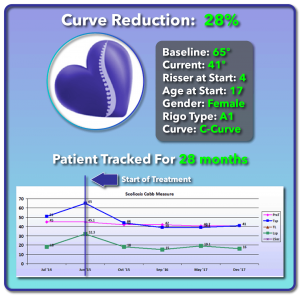Scoliosis Treatment Results
Written and reviewed for scientific and factual accuracy by Dr. Austin Jelcick, PhD and Dr. Matthew Janzen, DC. Last reviewed/edited on March 4, 2024.
Where do you fit?
No two people are the same, thus no two spines are the same; this is especially true when concerning scoliosis. There are many factors that go into determining how successful one will be when treating scoliosis and the scoliosis curve reduction one can expect. These include; initial Cobb angle, age, gender, Risser (or growth stage), compliance, the shape of the curve (C-curve or S-curve), and more. If we thoroughly understand each patient and their curve, we can then develop realistic expectations for their treatment and maximize their scoliosis treatment results.
What Is Your Curve Size?
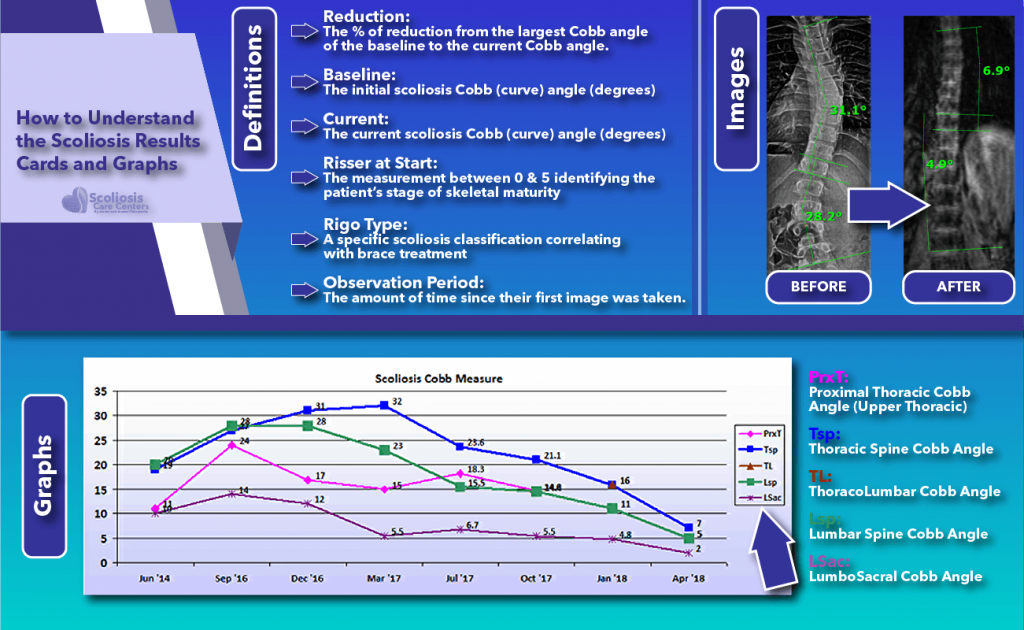
Category: 10-24°
Success Rate:
100%
Success Rate Defined
The percentage of cases in this category that were prevented from progressing to surgical range (40 degrees)
Average Reduction:
47%
Avg Reduction Defined
The average of ALL patients who started the program, not filtered for compliance. This includes patients who worked hard and those who did not
Our Best Reduction:
86%
Best Reduction Defined
Our largest percent reduction on record for cases that began with a Cobb Angle between 10 to 24 degrees.
10-24º Category: Case 1 Result Details
Beginning Curve Size: 21 degrees
Final Curve Size: 7 degrees
Scoliosis Reduced By: 68%
Age at Start of Treatment: 12 years old
Risser at Start of Treatment: Risser 1
Observation Period: 18 months
10-24º Category: Case 2 Result Details
Beginning Curve Size: 18 degrees
Final Curve Size: 13 degrees
Scoliosis Reduced By: 27%
Age at Start of Treatment: 12 years old
Risser at Start of Treatment: Risser 3
Observation Period: 6 months
10-24º Category: Case 3 Result Details
Beginning Curve Size: 18 degrees
Final Curve Size: 4 degrees
Scoliosis Reduced By: 78%
Age at Start of Treatment: 13 years old
Risser at Start of Treatment: Risser 0
Observation Period: 27 months
10-24º Category: Case 4 Result Details
Beginning Curve Size: 25 degrees
Final Curve Size: 3 degrees
Scoliosis Reduced By: 88%
Age at Start of Treatment: 11 years old
Risser at Start of Treatment: Risser 0
Observation Period: 23 months
Category: 25-39°
Success Rate:
98%
Success Rate Defined
The percentage of cases in this category that were prevented from progressing to surgical range (40 degrees)
Average Reduction:
36%
Avg Reduction Defined
The average of ALL patients who started the program, not filtered for compliance. This includes patients who worked hard and those who did not
Our Best Reduction:
78%
Best Reduction Defined
Our largest percent reduction on record for cases that began with a Cobb Angle between 25 to 39 degrees
25-39º Category: Case 1 Result Details
Beginning Curve Size: 37 degrees
Final Curve Size: 8 degrees
Scoliosis Reduced By: 88%
Age at Start of Treatment: 10 years old
Risser at Start of Treatment: Risser 0
Observation Period: 23 months
25-39º Category: Case 2 Result Details
Beginning Curve Size: 29 degrees
Final Curve Size: 12 degrees
Scoliosis Reduced By: 59%
Age at Start of Treatment: 7 years old
Risser at Start of Treatment: Risser 0
Observation Period: 30 months
25-39º Category: Case 3 Result Details
Beginning Curve Size: 33 degrees
Final Curve Size: 13 degrees
Scoliosis Reduced By: 62%
Age at Start of Treatment: 13 years old
Risser at Start of Treatment: Risser 0
Observation Period: 8 months
25-39º Category: Case 4 Result Details
Beginning Curve Size: 31 degrees
Final Curve Size: 10 degrees
Scoliosis Reduced By: 67%
Age at Start of Treatment: 16 years old
Risser at Start of Treatment: Risser 4
Observation Period: 24 months
25-39º Category: Case 5 Result Details
Beginning Curve Size: 39 degrees
Final Curve Size: 24 degrees
Scoliosis Reduced By: 40%
Age at Start of Treatment: 13 years old
Risser at Start of Treatment: Risser 1
Observation Period: 19 months
25-39º Category: Case 6 Result Details
Beginning Curve Size: 26 degrees
Final Curve Size: 10 degrees
Scoliosis Reduced By: 63%
Age at Start of Treatment: 10 years old
Risser at Start of Treatment: Risser 0
Observation Period: 10 months
25-39º Category: Case 7 Result Details
Beginning Curve Size: 37 degrees
Final Curve Size: 12 degrees
Scoliosis Reduced By: 67%
Age at Start of Treatment: 14 years old
Risser at Start of Treatment: Risser 4
Observation Period: 16 months
25-39º Category: Case 8 Result Details
Beginning Curve Size: 38 degrees
Final Curve Size: 22 degrees
Scoliosis Reduced By: 42%
Age at Start of Treatment: 12 years old
Risser at Start of Treatment: Risser 0
Observation Period: 49 months
25-39º Category: Case 9 Result Details
Beginning Curve Size: 30 degrees
Final Curve Size: 10 degrees
Scoliosis Reduced By: 68%
Age at Start of Treatment: 14 years old
Risser at Start of Treatment: Risser 1
Observation Period: 32 months
25-39º Category: Case 10 Result Details
Beginning Curve Size: 36 degrees
Final Curve Size: 9 degrees
Scoliosis Reduced By: 75%
Age at Start of Treatment: 10 years old
Risser at Start of Treatment: Risser 0
Observation Period: 36 months
25-39º Category: Case 11 Result Details
Beginning Curve Size: 28 degrees
Final Curve Size: 7 degrees
Scoliosis Reduced By: 76%
Age at Start of Treatment: 14 years old
Risser at Start of Treatment: Risser 0
Observation Period: 21 months
25-39º Category: Case 12 Result Details
Beginning Curve Size: 31 degrees
Final Curve Size: 7 degrees
Scoliosis Reduced By: 77%
Age at Start of Treatment: 12 years old
Risser at Start of Treatment: Risser 0
Observation Period: 16 months
25-39º Category: Case 13 Result Details
Beginning Curve Size: 30 degrees
Final Curve Size: 12 degrees
Scoliosis Reduced By: 59%
Age at Start of Treatment: 13 years old
Risser at Start of Treatment: Risser 2
Observation Period: 28 months
25-39º Category: Case 14 Result Details
Beginning Curve Size: 35 degrees
Final Curve Size: 15 degrees
Scoliosis Reduced By: 58%
Age at Start of Treatment: 15 years old
Risser at Start of Treatment: Risser 4
Observation Period: 22 months
Category: 40-50°
Success Rate:
78%
Success Rate Defined
The percentage of cases in this category that were reduced from surgical range (40 degrees) to below
Average Reduction:
32%
Avg Reduction Defined
The average of ALL patients who started the program, not filtered for compliance. This includes patients who worked hard and those who did not
Our Best Reduction:
76%
Best Reduction Defined
Our largest percent reduction on record for cases that began with a Cobb Angle between 40 to 50 degrees.
40-50º Category: Case 1 Result Details
Beginning Curve Size: 50 degrees
Final Curve Size: 17 degrees
Scoliosis Reduced By: 66%
Age at Start of Treatment: 9 years old
Risser at Start of Treatment: Risser 0
Observation Period: 60 months
40-50º Category: Case 2 Result Details
Beginning Curve Size: 50 degrees
Final Curve Size: 21 degrees
Scoliosis Reduced By: 59%
Age at Start of Treatment: 13 years old
Risser at Start of Treatment: Risser 4
Observation Period: 21 months
40-50º Category: Case 3 Result Details
Beginning Curve Size: 50 degrees
Final Curve Size: 29 degrees
Scoliosis Reduced By: 42%
Age at Start of Treatment: 15 years old
Risser at Start of Treatment: Risser 4
Observation Period: 18 months
40-50º Category: Case 4 Result Details
Beginning Curve Size: 46 degrees
Final Curve Size: 22 degrees
Scoliosis Reduced By: 52%
Age at Start of Treatment: 14 years old
Risser at Start of Treatment: Risser 0
Observation Period: 18 months
40-50º Category: Case 5 Result Details
Beginning Curve Size: 46 degrees
Final Curve Size: 29 degrees
Scoliosis Reduced By: 37%
Age at Start of Treatment: 12 years old
Risser at Start of Treatment: Risser 1
Observation Period: 3 months
Category: 51-64°
Success Rate:
66%
Success Rate Defined
The percentage of cases in this category that were reduced from surgical range (50 degrees) to below
Average Reduction:
19%
Avg Reduction Defined
The average of ALL patients who started the program, not filtered for compliance. This includes patients who worked hard and those who did not
Our Best Reduction:
51%
Best Reduction Defined
Our largest percent reduction on record for cases that began with a Cobb Angle between 51 to 64 degrees
51-64º Category: Case 1 Result Details
Beginning Curve Size: 62 degrees
Final Curve Size: 39 degrees
Scoliosis Reduced By: 37%
Age at Start of Treatment: 14 years old
Risser at Start of Treatment: Risser 2
Observation Period: 10 months
51-64º Category: Case 2 Result Details
Beginning Curve Size: 60 degrees
Final Curve Size: 37 degrees
Scoliosis Reduced By: 38%
Age at Start of Treatment: 12 years old
Risser at Start of Treatment: Risser 2
Observation Period: 16 months
51-64º Category: Case 3 Result Details
Beginning Curve Size: 60 degrees
Final Curve Size: 40 degrees
Scoliosis Reduced By: 33%
Age at Start of Treatment: 14 years old
Risser at Start of Treatment: Risser 0
Observation Period: 17 months
51-64º Category: Case 4 Result Details
Beginning Curve Size: 60 degrees
Final Curve Size: 45 degrees
Scoliosis Reduced By: 25%
Age at Start of Treatment: 14 years old
Risser at Start of Treatment: Risser 4
Observation Period: 22 months
Category: 65+°
65+º Category: Case 1 Result Details
Beginning Curve Size: 90 degrees
Final Curve Size: 60 degrees
Scoliosis Reduced By: 33%
Age at Start of Treatment: 14 years old
Risser at Start of Treatment: Risser 4
Observation Period: 41 months
65+º Category: Case 2 Result Details
Beginning Curve Size: 83 degrees
Final Curve Size: 64 degrees
Scoliosis Reduced By: 23%
Age at Start of Treatment: 13 years old
Risser at Start of Treatment: Risser 2
Observation Period: 35 months
65+º Category: Case 3 Result Details
Beginning Curve Size: 65 degrees
Final Curve Size: 47 degrees
Scoliosis Reduced By: 28%
Age at Start of Treatment: 7 years old
Risser at Start of Treatment: Risser 0
Observation Period: 9 months
65+º Category: Case 4 Result Details
Beginning Curve Size: 65 degrees
Final Curve Size: 48 degrees
Scoliosis Reduced By: 27%
Age at Start of Treatment: 14 years old
Risser at Start of Treatment: Risser 4
Observation Period: 51 months
65+º Category: Case 5 Result Details
Beginning Curve Size: 65 degrees
Final Curve Size: 47 degrees
Scoliosis Reduced By: 28%
Age at Start of Treatment: 17 years old
Risser at Start of Treatment: Risser 4
Observation Period: 9 months
We can see from the images and results above that the scoliosis treatment results obtained by our patients and their treatment success directly relates to the size of the curve, as well as how mature the child is skeletally. The sooner we catch the curve and begin treatment, and the younger the child, the better the outcome.
This concept is explained in detail on our treatment page, but the key concepts are that (1) we can use a child’s growth as a corrective force to straighten the spine; (2) the curve has not been present as long and thus the spine is not as “stuck”; (3) treatment should be continued until the child has finished growing.
Take home message: Early detection allows for early intervention and non-surgical treatment; allowing for better treatment results and the best chance for a straight spine; avoiding surgery; and a happy, healthy adulthood!

